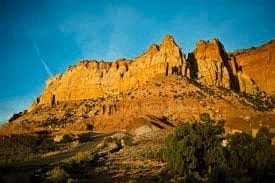A Canadian Firm Prepares To Mine Land Trump Cut From Monument Protection – By Chris D’Angelo (huffpost.com) / June 19 2018
The company has entered into an agreement to purchase mineral rights to a former copper mine site within the original boundary of Grand Staircase-Escalante.

A Canadian company is looking to extract copper and other minerals from the site of a former mine that was, until recently, within the boundary of Grand Staircase-Escalante National Monument and off limits to such development.
The land was part of one of two protected sites in southern Utah that President Donald Trump removed from monument protection late last year.
Glacier Lake Resources Inc., a Vancouver-based copper and silver mining firm, announced the acquisition of the Colt Mesa deposit in a press release last week, noting that the “area recently became open for staking and exploration after a 21 year period moratorium.” The company is moving forward with an effort to mine copper, cobalt and other minerals from the approximately 200-acre parcel.
President Bill Clinton established the Grand Staircase-Escalante National Monument in 1996. In December, Trump cut the 1.87 million-acre site, the largest land national monument in the country, roughly in half. The nearby 1.35 million-acre Bears Ears National Monument was slashed by 85 percent. The moves opened the door for oil, gas and other development.
The Glacier Lake Resources announcement signals the first threat of new mining on land cut from either national monument.
 Colten Hoyt/Contributed photo. The Colt Mesa mine, pictured here on Monday, operated intermittently in the 1970s. Glacier Lake Resources Inc., a Vancouver-based mining firm, has acquired mineral rights and is moving to begin extracting copper, cobalt and other minerals.
Colten Hoyt/Contributed photo. The Colt Mesa mine, pictured here on Monday, operated intermittently in the 1970s. Glacier Lake Resources Inc., a Vancouver-based mining firm, has acquired mineral rights and is moving to begin extracting copper, cobalt and other minerals.
Colter Hoyt, a backcountry guide and longtime advocate for protections for Grand Staircase-Escalante, told HuffPost he visited the mine site Monday and found new stakes in the ground and a fresh hole where company workers accessed the sealed-off mine. A metal gate and lock have been installed over the hole to keep the public out.
Hoyt said the area around the mine is key to the area’s tourism economy. Visitors use the dirt road that leads to the site to go hiking, canyoneering and rock climbing. He said he “can’t imagine” watching mining vehicles driving back and forth along the road and fears this will be the first of many instances of national monuments being “sold off to extraction companies.”
Located in the Circle Cliffs area, approximately 35 miles southeast of Boulder, Utah, the Colt Mesa deposit was discovered in 1968. Along with copper, it contains cobalt, zinc and nickel. A mine opened at the site in 1971 and operated on and off until 1974, when it was shut down due to a lack of water, according to a 1975 geological report by a master’s student at the University of Utah.
Saf Dhillon, president and CEO of Glacier Lake Resources, told HuffPost over email that the firm is in the “very early stage” of assessing the property. Asked about monument supporters concerns about the impact mining could have on tourism and the environment, Dhillon said “the target is a high value, underground scenario with modest disturbance.”
Dhillon declined to provide details about the size of the property or the vendor with whom the company has entered into an agreement to ultimately purchase mineral rights, saying that information has not been publicly disclosed. But records available on the Bureau of Land Management’s website show that a Dan and Nicholas Proctor staked 10 claims ― each just over 20 acres ― at the site on March 29.
Dhillon said that if all requirements of the agreement are met, the company will purchase the mineral rights in full.
Glacier Lake Resources has agreed to pay the vendors $120,000 over a two-year period, plus a million common shares of its stock, currently valued at around $45,000.
The company says it conducted sampling during a recent site visit and confirmed the presence of several minerals, including cobalt, one of the 35 minerals that the Department of the Interior has identified as critical to the United States’ economic and national security. Cobalt is used in rechargeable batteries, airbags and superalloys in gas turbine engines.
In a statement accompanying Glacier Lake Resources’ release, Dhillon called the project “a welcome addition to the company’s every growing portfolio.”
“Surface exploration work will start this summer on the Colt Mesa property and drill permitting will be initiated shortly,” he said.
BLM did not immediately respond to a request for comment.
Colt Mesa is Glacier Lake Resources’ first project in the U.S. The Vancouver-based company also has three other mining projects in British Columbia, according to its website.
Trump signed a pair of executive orders in April 2017 that threatened the future of 27 national monuments. At the signing ceremony, he boasted that he would end “another egregious abuse of federal power,” put “states back in charge” and open up protected areas to “tremendously positive things.” Many expected that meant mining and drilling.
Trump traveled to Salt Lake City in December, where he signed a pair of proclamations dismantling the two Utah monuments. The action ― the largest reduction of national monuments in history ― was met with a slew of legal challenges from Native American tribes and environmental groups.
The administration has repeatedly said the rollback was not about energy or mineral development, despite media reports that suggest otherwise.
“I’m a geologist,” Interior Secretary Ryan Zinke said at a congressional budget hearing in May. “I can assure you that oil and gas in Bears Ears was not part of my decision matrix. … And there is no proposal that I’ve seen to mine uranium in the former area of Bears Ears.”



















